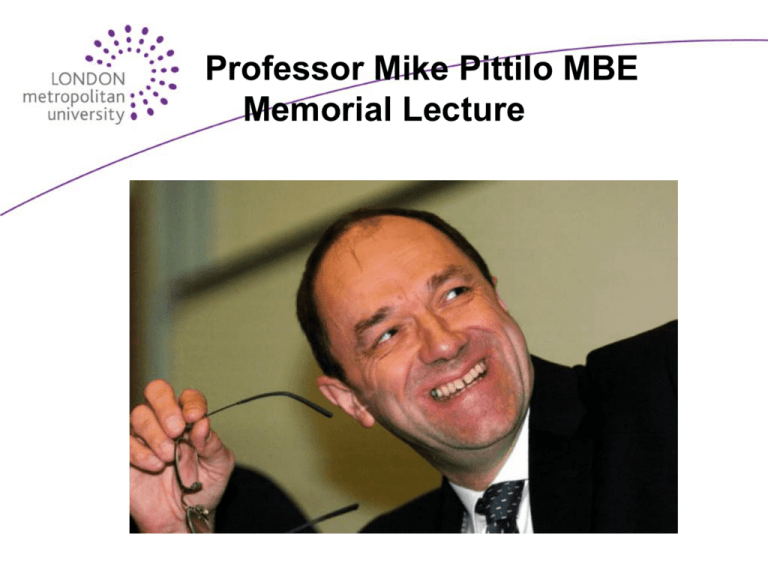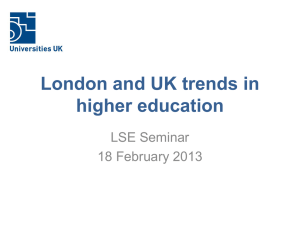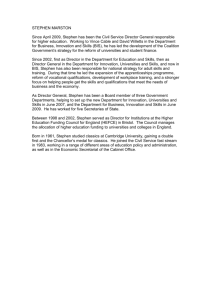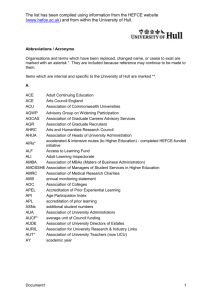C_A_Mike_Pittilo_2011_Peter_Mcaffrey
advertisement

Professor Mike Pittilo MBE Memorial Lecture Change Academy 2011 Sashaying Along The Ice Floe ! Leading Change in Universities Today 8 September 2011 Peter McCaffery London Metropolitan University UNIVERSITY COMMITTEES AS AN ART FORM How University committees avoid making decisions: John Kay’s “8 oars of indecision” • • • • Deferral Referral Points of order The wider picture - • • • • Evasion Ambiguity Precedent Denial - wait until next time to another committee procedural objection we need to understand the context better we need still further detail accept in principle, but not in practice let’s not set one not for us to decide EFFECTIVE MANAGEMENT OF CHANGE IN UNIVERSITIES IS DEPENDENT ON: • Knowing Your Environment • Knowing Your Institution • Knowing Your Department • Knowing Yourself! External Environment (since August, 2008) • Global financial crisis; economic downturn • UK public debt “approaching Armageddon levels” (Audit Commission forecast) • Politics of the “New Normal” - the dearth of public money; “value for money” - “living within our means” - “doing more with less while still maintaining quality” • Funding changes - HE budget cut £1.09B (pre-May 2010); £2.9B (2010-14) - Shift of burden from taxpayer to graduate; fee cap now £9K/yr • From “a golden era” to “a new iron age” (Scott) TRADITIONAL ROLE OF MODERN UNIVERSITY • FINISHING SCHOOL: Last stage of general education • PROFESSIONAL SCHOOL: Training of elite workers • KNOWLEDGE FACTORY: Production of science, technology and ideology • CULTURAL INSTITUTION: Expression of our individual and collective sense of being • 21st Century: multiple roles – lifelong learning, knowledge transfer, international students . . . . . . THE UNIVERSITY IDENTITY CRISIS The University: • Redundant as an “Idea”? • Broken as a Monopoly • Confronted with unprecedented change NEW WAVE COMPETITORS Mega Univs UKOU, AU Turkey, China TV For-Profit Univs BPP, Kaplan, Phoenix Corporate Univs BAE, Disney, Ford, Microsoft, Motorola, Unipart Private HE Training Orgs Apollo, DeVry, Laureate, Strayer Sleeping Giants IBM, News Int., Pearson EXTERNAL DRIVERS CONTINUING EXPANSION OF STUDENT NUMBERS (UK AND WORLDWIDE) WIDENING PARTICIPATION ‘fair access’/bursaries FUNDING variable fee fund-raising diversifying income sources full economic costing MARKETING positioning of HEIs identity/’brand’ issues HR retirement peak succession planning pay framework performance assessment COMPETITION IN UK alliances, collaborations and mergers IT E-MANAGEMENT/E-LEARNING BIS E-strategy 15 key strategic challenges for UK HE institutions, 2011- 2014 ENHANCING THE STUDENT EXPERIENCE teaching, learning and quality ‘customer service’ RESOURCES AND ESTATES DEVELOPMENT sustainable facilities and services project and programme management MANAGEMENT OF RESEARCH evolution of RAE/REF process research contracts & careers academic pipeline GOVERNANCE Code and CUC Guidance INTERNATIONALISATION competition/collaboration European research area private universities Bologna process SUSTAINABILITY AND CORPORATE SOCIAL RESPONSIBILITY serving broader political, social, ethical and cultural agendas BUSINESS, REGIONAL & COMMUNITY INTERACTIONS ‘third stream’ knowledge transfer, economic & social regeneration EMBEDDING EQUALITY AND DIVERSITY IN ALL INSTITUTIONAL ACTIVITIES STAKEHOLDERS IN HE SECTOR Political Fiduciary BIS Ministers, PAC, HMT DTI / OST Funding HEFCE BIS RCs/Operations LEAs, NHS, TDA, charities, EU , MoD, business Sponsors HEFCE, UUK, Guild HE, TDAs HEFCE Agency HEFCE, HESA, QAA, Ofsted, UCAS, NAO Professional GMC, ENB, Law Society, ACCA, GDC, BPS, etc. Higher Education Institutions Council / Governors Vice Chancellor Senior Management Faculties / Departments Staff UCU Students (+ parents, schools) DCFS UCAS Employers CBI, etc. Business Community RDAs, SSCs, LSs, (LSC) etc. Traditional HE New HE Competition: other univs. Competition: everywhere Student as apprentice scholar Learner as Customer (and Producer) Delivery in the classroom Delivery everywhere Bricks and mortar - Physical estates Bits and bytes - Virtual estates Technology as an Expense Technology as Market Differentiation Institutional - centric Market – centric Funding: Block grant Funding: student fees Independent Supplier Shared Services Traditional HE New HE Terminal degree Lifelong learning Take what is offered Courses on demand Academic calendar Year round campus Course as 3-4 year revenue Course as Business Plan Mode 1 Knowledge Mode 2 Knowledge Teacher as Director of Learning Teacher as Facilitator of Learning Academic as “jack of all trades” Academic as specialist Diversity as problem Diversity as strength UNIVERSITY CHALLENGE • Average size of Universities has doubled in 40 years • Greater internal organisational complexity • Greater external accountability • More volatile competitive environment • Challenge - To change or risk being overwhelmed DISTINGUISHING FEATURES OF UNIVERSITIES • the autonomy of the individual scholar • precedence of subject over institutional loyalty • the strength of tradition • the cult of the “expert” Collegiality managerialism post-managerialism? MODELS OF UNIVERSITIES AS ORGANISATIONS Policy Definition loose Control of Implementation A: B: Collegium Bureaucracy tight loose D: C: Enterprise Corporation tight “The University is a community of scholars engaged in the task of seeking truth”. Karl Jaspers, 1923 “I find the three major administrative problems on campus are sex for the students, athletics for the alumni and car parking for the faculty”. Clark Kerr President, University of California, 1958 EXEMPLARS OF STRUGGLING INNOVATORS (1) HEIs Conversation theme ‘Message’ Regional University South Australia ‘I’ve been parking my car under that tree for 28 years or more’. The latest change initiative can just go hang. ‘Wake me when its over’ Research University Eastern Australia ‘You need the personality of a It’s rough, it’s tough and Sherman tank to survive as head of there is no end in sight. The department here’. industrial model is just not suited to an HE environment. EXEMPLARS OF STRUGGLING INNOVATORS (2) HEIs Conversation theme ‘Message’ Regional Research ‘He (the president) used to come University Northeastern out of the ‘puzzle palace’ with a USA guard of honour.’ ‘It was like Moses coming off the mountain with the tablets” (The Strategic Plan). Who knows what the executive does or thinks – you can’t get near them. Collegiality? You gotta be kidding. Regional Research University Eastern USA It’s a Darwinian jungle in this state and we’re ahead of the game. Outsourcing is all the rage here and could be next. The ‘meat-axe administrator’ and his refrain: ‘We already did that yesterday?’ ‘They slough it off here, slough it off there, slough it off everywhere’. What is special about the climate and culture of your University? What is special about the climate and culture of your Department? CULTURAL INQUIRY – engagement • • • • • • • Appreciative Enquiry Liquid Café Open Space Rich pictures World Cafe (Framing and re-framing your institution) (Maintaining a multiple mind-set) THE MAIN SOURCES OF ORGANISATIONAL POWER AUTHORITY - hierarchical relations resources - the right to decide -legitimacy -criteria THE PERCEPTIONS VALUES & INTERESTS WITHIN YOUR UNIVERSITY EXPERTISE - scarcity/substitutability - credibility - authenticated - relevance RESOURCE CONTROL - control over valued resources physical/symbolic - gamekeeping/allocation criteria - credibility INTERPERSONAL SKILLS - ‘charisma’ - advocacy - assertiveness - networking How powerful am I? Am I using all my political resources? 1. What are your political resources? Make an Inventory 2. What is your network of power? Make an Analysis LEADING CHANGE: SOME GUIDING PRINCIPLES • • • • • Leadership is not vested in a single great figure; it exists throughout the University Leadership is as much about groups and teams as it is to do with individuals Leaders are, by and large made, not born The institutional context and leadership approach are as important as personal attributes Effective managers can also be effective leaders and vice versa “Leaders do the right thing, managers do things right” – Peter Drucker PROMPTS FOR LEADING AND MANAGING CHANGE.. BEWARE THE “BUSY PERSON SYNDROME”: INDIVIDUAL BEHAVIOURS High FOCUS Low disengaged 20% purposeful action-takers 10% procrastinators 30% distracted 40% Low ENERGY High FOUNDATIONS FOR MANAGING YOURSELF • We never see the world as it is, only as we are. • “I wish some power the gift would gi’e us, to see ourselves as others see us”. - Robbie Burns • “Be not another’s if thou canst be thyself”. - Paracelsus • Our “concept of self” is neither fixed nor permanent - self-ideal; self-image; self-esteem • We always have choices YOUR VALUES, MOTIVES AND BEHAVIOURS Known to Self Known to others 1 OPEN Not Known to others 3 HIDDEN The Johari Window Not Known to Self 2 BLIND 4 UNKNOWN SUCCESSFUL UNIVERSITY INNOVATORS Common Traits in managing change: • • • • • • No Magic Pill Distributed Leadership – a quality tapped at all levels “Art of Conversation”: a core process Harnessing collegiality as an aspiration Building on existing good practice (avoiding deficit models) “Learners “as well as “Knowers” – advocates of an inquiry approach LEADERSHIP CHALLENGE 1 RECOGNISING POPULAR MYTHS ABOUT THE MANAGEMENT OF CHANGE FOR WHAT THEY ARE • Change can only occur if it is driven from the top • People are resistant to change • People are rational and will react to logical and rational requests for change • New processes and systems will create the new necessary behaviours • Big changes require big actions • If it ain’t broke, don’t fix it • Cultural change is a slow and painful long-term affair LEADERSHIP CHALLENGE 2 RECOGNISING THE FUNDAMENTALS IN THE SUCCESSFUL MANAGEMENT OF CHANGE • Change must presage a new model for the future • People must have a reason. Change will not succeed unless there is a dis-satisfaction with the old • Major change can be painful – resistance is normal • Change is “lumpy”: people, systems and processes change at different rates and in different ways • Change is an ongoing process, not an event • Change is unique to each institution. Celebrate your individual landmarks of success 29 LEADERSHIP CHALLENGE 3 PAVING THE WAY • Begin the conversation • Open up your creative self and encourage others to do likewise • Prepare to give up power – backstage leadership • Identify, nurture and support networks and champions • Surface and test mental models held by colleagues • Defuse defensive routines and be open about your own • Establish genuine shared values and agree associated behaviours • Model expected behaviours Any questions? 31







